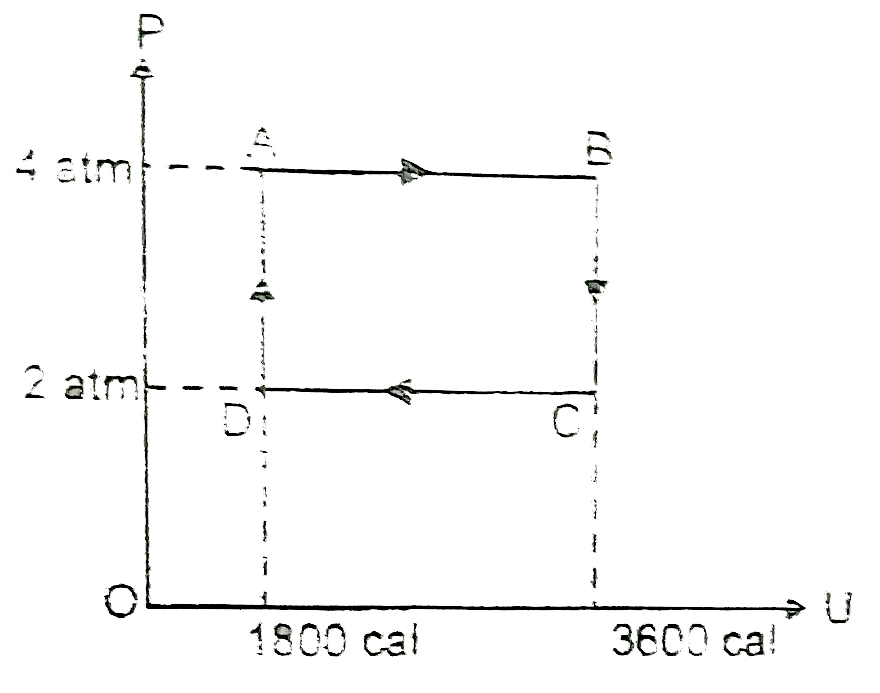An ideal monoatomic gas undergoes a process in which its internal energy U and density ρ vary as Uρ= constant. The ratio of change in internal energy and the work done by the gas is
The correct Answer is:C
To solve the problem, we need to find the ratio of the change in internal energy (ΔU) to the work done (W) by the gas during the specified process. The process is defined by the relationship U⋅ρ=constant.
1. Understanding the Given Relationship:
We are given that U⋅ρ=constant. This implies that as the density ρ changes, the internal energy U changes in such a way that their product remains constant.
2. Expressing Density:
The density ρ can be expressed as:
ρ=mV
where m is the mass and V is the volume. Since the mass of the gas remains constant, we can say that ρ is inversely proportional to V:
ρ∝1V
3. Relating Internal Energy to Temperature:
For an ideal monoatomic gas, the internal energy U is directly proportional to the temperature T:
U=32nRT
where n is the number of moles and R is the gas constant.
4. Connecting Temperature and Volume:
Since U⋅ρ=constant, we can express this in terms of temperature and volume:
U⋅ρ=32nRT⋅mV=constant
This implies that T must vary with V such that the product remains constant.
5. Using the First Law of Thermodynamics:
The first law of thermodynamics states:
ΔU=Q−W
For an isobaric process (constant pressure), the work done W can be expressed as:
W=PΔV
where P is the pressure.
6. Finding the Ratio:
From the first law, we can rearrange it to find W:
W=Q−ΔU
If we consider the specific heat at constant volume CV and at constant pressure CP, we know:
CP−CV=R
For a monoatomic gas, CV=32R and CP=52R.
7. Calculating the Ratio:
The ratio of the change in internal energy to the work done can be expressed as:
ΔUW=nCVΔTnCPΔT=CVCP
Substituting the values:
ΔUW=32R52R=35
Final Answer:
The ratio of the change in internal energy to the work done by the gas is:
ΔUW=35
We are given that U⋅ρ=constant. This implies that as the density ρ changes, the internal energy U changes in such a way that their product remains constant.
The density ρ can be expressed as:
ρ=mV
where m is the mass and V is the volume. Since the mass of the gas remains constant, we can say that ρ is inversely proportional to V:
ρ∝1V
For an ideal monoatomic gas, the internal energy U is directly proportional to the temperature T:
U=32nRT
where n is the number of moles and R is the gas constant.
Since U⋅ρ=constant, we can express this in terms of temperature and volume:
U⋅ρ=32nRT⋅mV=constant
This implies that T must vary with V such that the product remains constant.
The first law of thermodynamics states:
ΔU=Q−W
For an isobaric process (constant pressure), the work done W can be expressed as:
W=PΔV
where P is the pressure.
From the first law, we can rearrange it to find W:
W=Q−ΔU
If we consider the specific heat at constant volume CV and at constant pressure CP, we know:
CP−CV=R
For a monoatomic gas, CV=32R and CP=52R.
The ratio of the change in internal energy to the work done can be expressed as:
ΔUW=nCVΔTnCPΔT=CVCP
Substituting the values:
ΔUW=32R52R=35
The ratio of the change in internal energy to the work done by the gas is:
ΔUW=35
Topper's Solved these Questions
Similar Questions
In an isothermal expansion change in internal energy and work done by the gas are respectively
View SolutionIn an isothermal expansion change in internal energy and work done by the gas are respectively
View SolutionAn ideal monoactomic gas undergoes a process ini which its internal energy depends upon its volume as
U=a√V [where a is a constant]
(a) find work done by a gas and heat transferred to gas to increse its internal energy by 200 J.
(b) find molar specific heat of gas for this process.
View SolutionChange in internal energy in an isothermal process for ideal gas is
View SolutionAn ideal diatomic gas (γ=75) undergoes a process in which its internal energy relates to the volume as U=α√V, where α is a constant.
(a) Find the work performed by the gas to increase its internal energy by 100J.
(b) Find the molar specific heat of the gas.
View SolutionThe internal energy of one mole of ideal gas is
View SolutionTwo moles of an ideal monoatomic gas undergo a cyclic process which is indicated on a P−U diagram, where U is the internal energy of the gas. The work done by the gas in the cycle is k×102In2. Find k.

View SolutionThe internal energy of non-ideal gas depends on
View SolutionTotal internal energy of an ideal gas remains constant in isothermal process.
View SolutionAn ideal gas with adiabatic exponent γ=43 undergoes a process in which internal energy is related to volume as U=V2 . Then molar heat capacity of the gas for the process is :
View Solution
